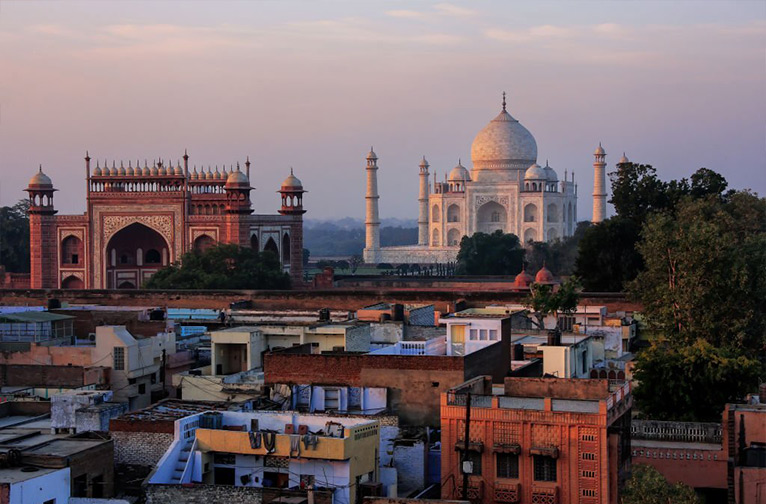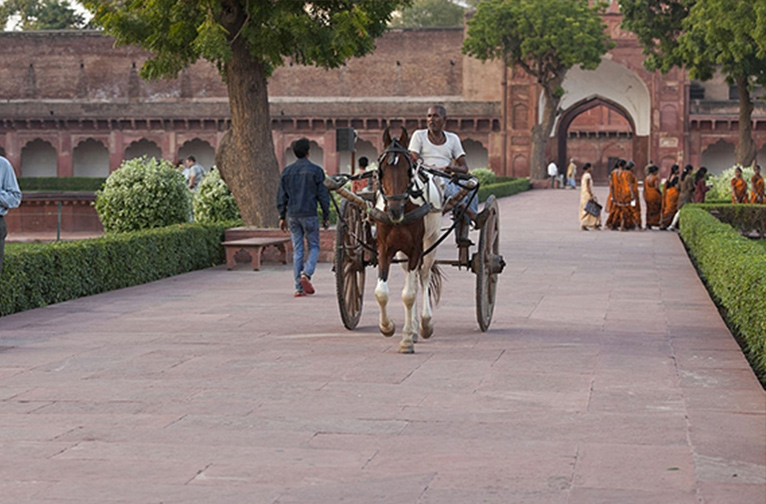Loitering around the back streets of this first Mughal bastion in India, it shouldn’t come as a surprise to you that Babur’s conquered city still has many narratives to reveal. That historical reversal of fortunes for the Sultanate of Delhi with the defeat of sultan Ibrahim Lodhi in the first battle of Panipat at the hands of the invader from Kabul, reverberated throughout India for over three centuries–from 1526 to 1857.
A Chagatai Turk, Babur was a fifth-generation descendant of Timur on the side of his father and a 14th-generation descendant of Genghis Khan. The empty coffers at Kabul and the constant threat of the Uzbegs on the horizon it was incentive enough for Babur, to turn his attention to the riches of Hindustan. Five successful raids from 1519 brought him booty and wealth unimaginable. The devasting defeat of Lodhi seduced him to establish Mughal rule in India, rather than return with the spoils of war to Kabul as he had done on previous occasions. With Agra, Lodi’s capital and Delhi with its treasury in his control by the spring of 1526 he had the keys to conquer Hindustan. At the peak of its rule the Mughal Empire was to command resources and fabulous wealth and glory, quite unprecedented in Indian history and covered almost the entire subcontinent.
Having settled in he brought his family and his extended household of aunts and cousins from Kabul into the embrace of the capital of his new found kingdom. Ill health and concerns with matters from Central Asia, Babur left his son Humayun to consolidate his conquests. Agra remained the power base for the Mughals between the 16th and 17th centuries till the court moved to Delhi.
The UNESCO Heritage ARC
The Taj


Emperor Shah Jehan’s pursuits as a connoisseur of the arts and all things beautiful dug deep into the enormous wealth at his command to create a fabulous memorial for his beloved wife Mumtaz Mahal. Word has it that while the Taj was envisioned as an opulent dream in pristine white marble mausoleum, he had plans to make a twin for himself in black marble. Myths and legends aside, the Taj for Mumtaz definitely catapulted dusty Agra into an unmissable must-visit destination down the centuries for travellers all over the world. Originally called the Rauza-i-munavvra (the illumined tomb), the Taj Mahal, set along the banks of the Yamuna River, is said to be the culmination of aesthetic splendour of both Mughal architecture and Indo-Islamic art. Ranked amongst the ‘New Seven Wonders of the World’ the Taj is a UNESCO-acclaimed World Heritage Site. The best time to enjoy an uncrowded viewing is sunrise, when the rosy flush of an Agra dawn transforms this pearly wonderment into an exquisite symbol of everlasting love. If you can’t make it at sunrise, find lose yourself in the serene confines of Babur’s Mehtab Bagh, across the Yamuna, to soak up its stunning visuals at sunset. On a moonlit night, bathed in the light of thousands of moonbeams it transports you to the celestial realms of an otherworldly experience.
Agra Fort
At a latticed window in the Musamman Burj at Agra Fort you can summon up the evocative visuals of the tears of a broken-hearted Shah Jehan clutching on to the memories of happier days with his beloved Mumtaz and the perfidy of an ambitious son, Aurangzeb, who has incarcerated him in this royal prison. When Akbar came to the throne the fort underwent extensive renovations including the replacement of the brick walls of the old structure of the fort with hewn rock. You get the best views of the river, right of the main gateway, from Jahangari Mahal, Akbar’s private apartments, where the emperor could watch elephant fights arranged for his entertainment on the banks of the river Numerous military campaigns, to bring Hindustan to its knees and to reign in rebellious sons, were planned and plotted from these august quarters in this fortress by the Mughal emperors.
Fatehpur Sikri
Emperor Akbar had a desire to build a new capital for himself at nearby Sikri. Built during the second half of the 16th century it was the first planned city of the Mughals complete with superb administrative, residential, and religious buildings filled with palaces, public buildings, mosques, and living areas for the court, the army and the palace servants. Structures of note in this vast red sandstone city were the Panch Mahal, an extraordinary, entirely columnar five-storey structure disposed asymmetrically on the pattern of a Persian badgir, or wind-catcher tower; the pavilion of Turkish Sultana; Anup Talao (Peerless Pool); Diwan-Khana-i-Khas and Khwabgah (Sleeping Chamber); palace of Jodha Bai, the largest with its richly carved interior pillars, balconies, perforated stone windows, and an azure-blue ribbed roof on the north and south sides and Birbal’s House.
The tomb of Saikh Salim Chisti, is a unique masterpiece of sculpted decoration, The Buland Darwaza, set at a height of 40 m, commemorated the victory of Gujarat in 1572. It is amongst one of the most perfect architectural achievements in India.
Fatehpur Sikri only served as his base for about 10 years, before the court had to yield to several issues which made it an unviable place to continue to be. One major problem it appears was the availability of potable water. Also with Akbar’s preoccupation with military matters and the shift of the imperial capital from Fatehpur Sikri to Lahore added to its neglect.
The ghost city looks its glorious best at sunrise or sunset when the play of lights and shadow offers inspirational moments for the artist in you.
Of Baghs and Bazaars
Babur took an instant dislike to Agra, which by his sensibilities was boorish, hot and lacking charm, like the rest of Hindustan. Missing the cool of the mountains Babur went about building gardens and palaces, water courses and bath houses in Agra, which held no charms for him except as base from where he aimed to rule Hindustan. As revealed by his memoirs he set up many verdant spaces by the Yamuna, including the Bagh-I-Gulafshan; Bagh-I-Zar-Afshan and Bagh-I-Hasht Bihisht. The Mehtab Garden was revived by Shah Jehan who enjoyed views of the Taj from its spot across the river.
Ram Bagh originally called the Bagh-i-Afshan upriver, 3km north of Itmad-ud–Daulah’s Tomb, is all that remains of the many gardens set up by emperor Babur in the city. Located on the Yamuna’s eastern banks it was the first Islamic charbagh garden in the country. Babur was laid to rest here when he died in 1530, before his remains were taken to be interred in his beloved Kabul on Shah-i-Kabul hill. The Mahatab Bagh, also near the Yamuna banks, across from the Taj Mahal, had fallen on hard times. A revival plan has made the garden a hot spot for the best sunset views of the Taj. Close to the Mahatab Garden is Gyarah Sidi the remains of an observatory built by emperor Humayun.
Close to the Jama Masjid lies sprawls a maze of intriguing serpentine lanes filled with a treasure trove of many delights. You will love the dazzle of Kinari Bazaar with its tinsels and embroidered and sequinned offerings. Further along the way the mithaiwallahas (sweetmeat sellers) will tempt you with Agra staples like petha, pani puri and allu kachori. As you plough deeper into the market the aromas, textures and colours of the spice street will transport you to the exotica of Indian culinary legacies.
Agra’s Mughal magic is a compelling narrative that begs to be explored on many repeat visits.